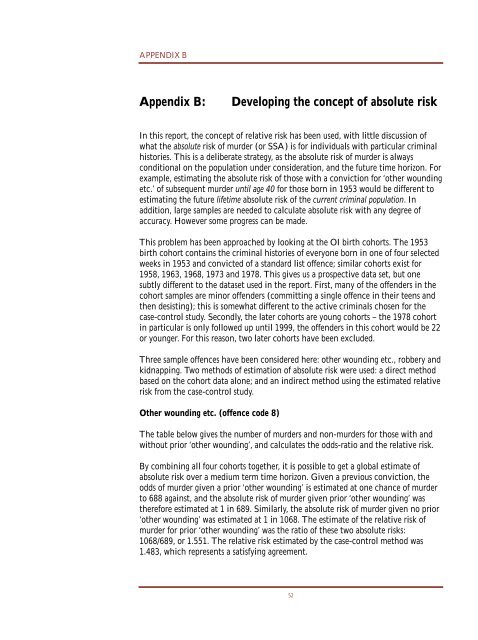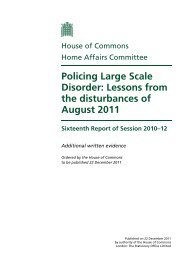Murder and Serious Sexual Assault - Lancaster EPrints - Lancaster ...
Murder and Serious Sexual Assault - Lancaster EPrints - Lancaster ...
Murder and Serious Sexual Assault - Lancaster EPrints - Lancaster ...
You also want an ePaper? Increase the reach of your titles
YUMPU automatically turns print PDFs into web optimized ePapers that Google loves.
APPENDIX B<br />
Appendix B: Developing the concept of absolute risk<br />
In this report, the concept of relative risk has been used, with little discussion of<br />
what the absolute risk of murder (or SSA) is for individuals with particular criminal<br />
histories. This is a deliberate strategy, as the absolute risk of murder is always<br />
conditional on the population under consideration, <strong>and</strong> the future time horizon. For<br />
example, estimating the absolute risk of those with a conviction for ‘other wounding<br />
etc.’ of subsequent murder until age 40 for those born in 1953 would be different to<br />
estimating the future lifetime absolute risk of the current criminal population. In<br />
addition, large samples are needed to calculate absolute risk with any degree of<br />
accuracy. However some progress can be made.<br />
This problem has been approached by looking at the OI birth cohorts. The 1953<br />
birth cohort contains the criminal histories of everyone born in one of four selected<br />
weeks in 1953 <strong>and</strong> convicted of a st<strong>and</strong>ard list offence; similar cohorts exist for<br />
1958, 1963, 1968, 1973 <strong>and</strong> 1978. This gives us a prospective data set, but one<br />
subtly different to the dataset used in the report. First, many of the offenders in the<br />
cohort samples are minor offenders (committing a single offence in their teens <strong>and</strong><br />
then desisting); this is somewhat different to the active criminals chosen for the<br />
case-control study. Secondly, the later cohorts are young cohorts – the 1978 cohort<br />
in particular is only followed up until 1999, the offenders in this cohort would be 22<br />
or younger. For this reason, two later cohorts have been excluded.<br />
Three sample offences have been considered here: other wounding etc., robbery <strong>and</strong><br />
kidnapping. Two methods of estimation of absolute risk were used: a direct method<br />
based on the cohort data alone; <strong>and</strong> an indirect method using the estimated relative<br />
risk from the case-control study.<br />
Other wounding etc. (offence code 8)<br />
The table below gives the number of murders <strong>and</strong> non-murders for those with <strong>and</strong><br />
without prior ‘other wounding’, <strong>and</strong> calculates the odds-ratio <strong>and</strong> the relative risk.<br />
By combining all four cohorts together, it is possible to get a global estimate of<br />
absolute risk over a medium term time horizon. Given a previous conviction, the<br />
odds of murder given a prior ‘other wounding’ is estimated at one chance of murder<br />
to 688 against, <strong>and</strong> the absolute risk of murder given prior ‘other wounding’ was<br />
therefore estimated at 1 in 689. Similarly, the absolute risk of murder given no prior<br />
‘other wounding’ was estimated at 1 in 1068. The estimate of the relative risk of<br />
murder for prior ‘other wounding’ was the ratio of these two absolute risks:<br />
1068/689, or 1.551. The relative risk estimated by the case-control method was<br />
1.483, which represents a satisfying agreement.<br />
52
















